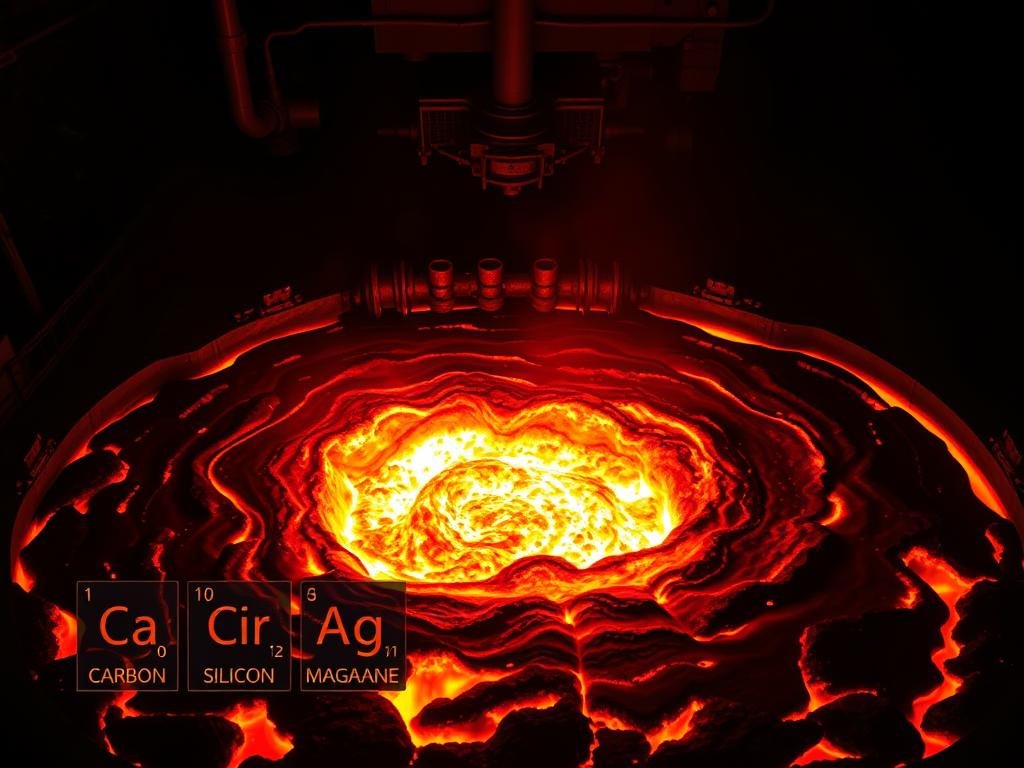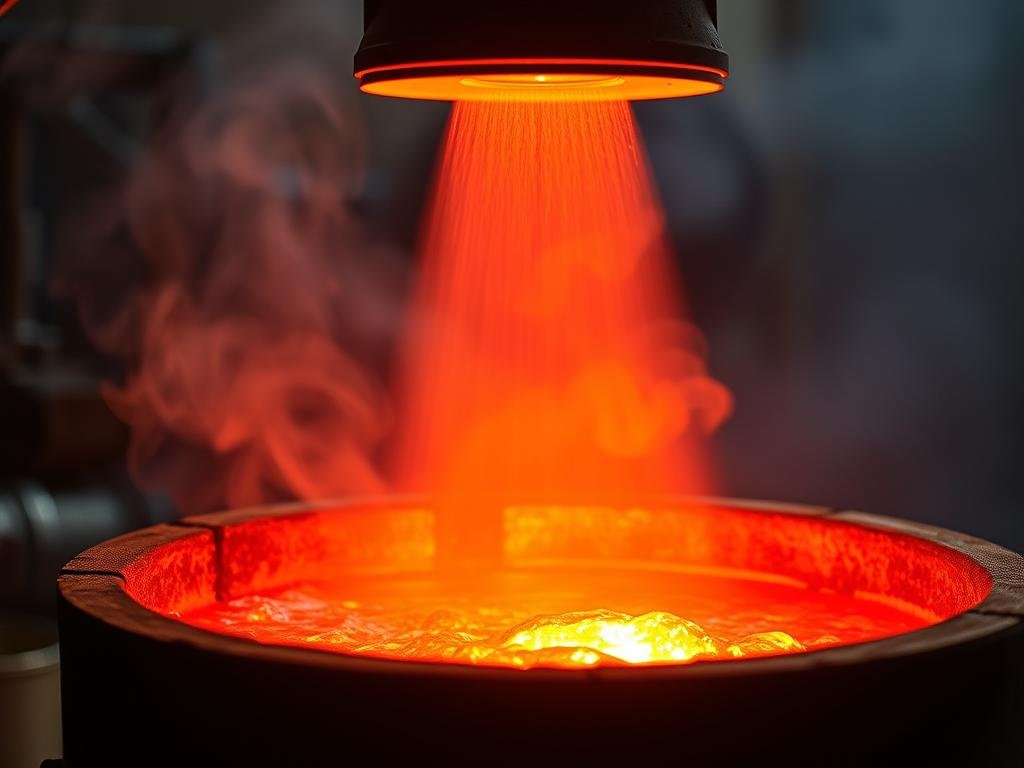Der melting point of iron, approximately 1,538°C (2,800°F), is a critical parameter in metallurgy and manufacturing. This fundamental property influences the behavior and applications of iron in various industries, from construction to automotive.
Bei einer so hohen Temperatur, iron’s strong atomic bonds require significant energy to break, making it a vital component in the production of steel and other alloys. Understanding the Schmelzeigenschaften of iron is essential for engineers and metallurgists working with iron-based materials.
This article will explore the science behind iron’s melting behavior, factors that affect it, and its significance in various industrial applications.
Understanding Iron’s Melting Point
Understanding the melting point of iron is essential for metallurgists and manufacturers alike. The melting point is a critical property that determines the usability of iron in various industrial applications.
What Is the Melting Point of Pure Iron?
Reines Eisen hat einen Schmelzpunkt von 1.538°C (2.800°F). Dies ist eine gut definierte physikalische Eigenschaft, die als Referenzpunkt für das Verständnis des Schmelzverhaltens verschiedener Eisenzusammensetzungen dient.
Melting Points of Different Types of Iron
Different types of iron exhibit varying melting points due to differences in their composition. For instance, cast iron melts at a significantly lower temperature range of 1,150-1,200°C (2,102-2,192°F) compared to pure iron. Gusseisen, with its minimal carbon content, has a melting range of 1,482-1,593°C (2,700-2,900°F).
As noted by experts, “The presence of carbon and other alloying elements significantly affects the melting point of iron alloys.” Various types of cast iron, including gray, white, and ductile iron, have distinct melting ranges based on their specific composition and microstructure.
- Der niedrigere Schmelzpunkt von Gusseisen macht es für Gießanwendungen geeignet.
- Carbon steel, an alloy of iron, melts between 1,425-1,540°C (2,597-2,804°F), demonstrating the impact of carbon content on melting temperature.
Faktoren, die den Schmelzpunkt von Eisen beeinflussen
Das Schmelzverhalten von Eisen wird durch mehrere wichtige Faktoren beeinflusst, einschließlich seiner Reinheit, der Anwesenheit von Verunreinigungen und den Druckbedingungen, unter denen es geschmolzen wird.
Purity and Composition
Die Reinheit und Zusammensetzung von Eisen beeinflussen seinen Schmelzpunkt erheblich. Reines Eisen hat einen bestimmten Schmelzpunkt, aber Variationen in der Zusammensetzung können diese Temperatur verändern.
Presence of Impurities
Impurities within iron can lower its melting point by introducing elements that have different melting behaviors, thus affecting the overall melting characteristics of the material.
Pressure Conditions
Pressure conditions also play a crucial role in determining iron’s melting point. At higher pressures, the melting point increases due to the need for more energy to overcome the increased atomic interactions.
| Faktor | Auswirkung auf den Schmelzpunkt | Relevance |
|---|---|---|
| Reinheit | Significant impact | Hoch |
| Impurities | Niedrigere Schmelztemperatur | Hoch |
| Druck | Erhöht den Schmelzpunkt | Mäßig |

Schmelzpunkt von Eisen in Herstellungsprozessen
Das Verständnis des Schmelzpunkts von Eisen ist entscheidend für die Optimierung von Herstellungsprozessen. Der Schmelzpunkt beeinflusst verschiedene industrielle Anwendungen, einschließlich Gießen, Schweißen, Schmieden und Wärmebehandlung.
Casting Applications
Beim Gießen wird Eisen über seinen Schmelzpunkt erhitzt, um einen flüssigen Zustand zu erreichen, sodass es in Formen gegossen werden kann. Die präzise Steuerung der Temperatur ist entscheidend, um Fehler zu vermeiden und die Qualität der Gussteile sicherzustellen.
Schweißüberlegungen
Schweißen beinhaltet das Verbinden von Eisenteilen durch Erhitzen auf eine hohe Temperatur, die oft die Schmelztemperatur annähert, aber nicht unbedingt überschreitet. Das thermische Management während des Schweißens ist entscheidend, um Verformungen oder Schwächungen des Materials zu verhindern.
Forging and Heat Treatment
Forging and heat treatment processes rely on heating iron to specific temperatures below its melting point. For instance, forging operations typically heat iron to between 900°C and 1,200°C, making it malleable. Heat treatment processes like annealing, quenching, and tempering also depend on precise temperature control relative to iron’s melting point.
| Prozess | Temperaturbereich (°C) | Zweck |
|---|---|---|
| Schmieden | 900 – 1,200 | Formendes Eisen |
| Anlassen | Approaching melting point | Relieve internal stresses |
| Löschung | Nahe 900 | Create specific microstructures |
| Härten | 150 – 650 | Balance hardness and toughness |
Methoden zum Schmelzen von Eisen
To melt iron, various methods are employed, each with its advantages and specific applications. The choice of method depends on factors such as the type of iron, the desired purity of the molten metal, and the specific requirements of the manufacturing process.
Blast Furnace Technology
Blast furnaces are a traditional method for melt iron, using a mixture of iron ore, coke, and limestone. This process is energy-intensive but can produce large quantities of molten iron.
Electric Arc Furnaces
Elektrische Lichtbogenöfen (EAFs) werden häufig zum Schmelzen von Metall, einschließlich Eisen, eingesetzt. EAFs verwenden einen elektrischen Lichtbogen, um das Metall zu erhitzen, und bieten eine energieeffizientere Alternative zu Hochöfen für bestimmte Anwendungen.
Induction Furnaces
An induction furnace employs electromagnetic induction to heat iron in a crucible efficiently. Key benefits include:
- Precise temperature control relative to iron’s melting point, ideal for specialty alloys.
- Non-contact heating minimizes contamination, producing higher purity metal.
- Rapid heating reduces energy consumption and oxidation losses.
- Gentle stirring action through electromagnetic forces creates homogeneous molten iron.
| Melting Method | Energy Efficiency | Purity Control |
|---|---|---|
| Hochofen | Niedrig | Mäßig |
| Electric Arc Furnace | Mäßig | Hoch |
| Induktionsofen | Hoch | Sehr hoch |
Vergleich des Schmelzpunkts von Eisen mit anderen Metallen
Der Schmelzpunkt von Eisen im Vergleich zu anderen Metallen spielt eine entscheidende Rolle in der Metallurgie und Materialwissenschaft. Dieser Vergleich ist wesentlich, um die Eignung von Eisen für verschiedene Anwendungen zu verstehen.
Common Industrial Metals
Industrial metals like nickel have melting points that are comparable or different from iron. For instance, nickel melts at 1,455°C, which is relatively close to iron’s melting point, making their alloys useful in certain applications.
Precious and Specialty Metals
Precious metals such as gold (1,064°C) and silver (961.8°C) have significantly lower melting points than iron. In contrast, specialty metals like tungsten (3,422°C) and molybdenum (2,623°C) have much higher melting points, making them ideal for high-temperature applications. As noted by a metallurgy expert, “The choice of metal often depends on its melting point and how it interacts with other elements.”
“The properties of metals, including their melting points, are crucial in determining their uses in various industries.”
This highlights the importance of comparing melting points to select the right metal for specific uses.
The Role of Carbon in Iron’s Melting Point
The presence of carbon in iron significantly influences its melting point, a crucial factor in metallurgical processes. This effect is particularly important in the production of steel and cast iron, where carbon content varies widely.
How Carbon Lowers Melting Temperature
Carbon lowers the melting temperature of iron by forming iron-carbon alloys. As carbon content increases, the melting point decreases. For instance, pure iron melts at 1,538°C, while cast irons with 2-4% carbon melt between 1,150-1,200°C.

Steel vs. Pure Iron Melting Points
Steel, an alloy of iron and carbon, has a melting point that varies with carbon content. Low-carbon steels melt around 1,500°C, while high-carbon steels melt between 1,380-1,430°C. This range is significantly lower than pure iron’s melting point, demonstrating carbon’s substantial influence on iron’s thermal behavior.
Conclusion: The Significance of Iron’s Melting Point in Modern Industry
As a fundamental property, iron’s melting point has far-reaching implications for its utilization in contemporary industry.
The melting point of iron, approximately 1,538°C (2,800°F), is a critical aspect of metal processing that influences various manufacturing techniques. From casting and forging to welding and heat treatment, knowing this critical property ensures that processes are executed efficiently and with high quality.
Proper management of the melting point enables the production of reliable and durable iron-based components, essential in many industrial applications. Modern manufacturing processes leverage sophisticated temperature control systems calibrated around iron’s melting characteristics to ensure consistent quality and performance in iron-based products.
The relationship between iron’s melting point and its crystalline structure continues to be an area of research that promises new insights into this ancient yet still critically important material. As industry continues to evolve, the fundamental knowledge of iron’s melting behavior remains essential for developing new materials and processes.
